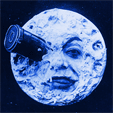Here's something different! Among my many collections you'll find a lot of pinback buttons of all kinds. And you know I love a complete set! Today's examples come from 1943, smack-dab in the middle of WWII - a set of 36 pins featuring military insignia, given out in boxes of Kellogg's Pep cereal (one pin per box).
I find the history of these pins to be fascinating, and of course there are the great graphics that seem to concentrate on air & bomber squadrons. Here are the first four (in my order, anyway). My favorite is the one on the left, with the grinning pilot, looking forward to dropping that bomb. You'll notice a number of pins with American Indian-inspired designs, probably because they looked cool. The 25th Bombardment Squadron pin is odd, is the axe-wielding man wearing swim fins? And how about a turkey for the 27th Fighter Squadron?
For reasons that are not entirely clear to me, the inks used on these wartime pins were particularly susceptible to chipping and wear, so it is pretty difficult to find these in decent condition. One person said the inks were meant to be child-safe, though that doesn't make much sense to me, considering that they all have a sharp brass pin on the back. Plus, did they make things "child safe" in 1943?
The rabbit riding a bomb is fun, is he wearing boxing gloves? The 34th Bomber Squadron "thunderbird" (?) graphic is particularly striking. And the creepy bat of the 44th Fighter Squadron gives me the willies.
I'm guessing that there was some ingredient that would normally have been used (bald eagle oil?), but was unavailable to Kellogg's during the war years. I thought my set was in pretty nice shape, but seeing them blown up reveals many flaws!
Here are four bombardment squadron pins, with animals dropping bombs, a gloved hand punching downward, and one large bomb heading straight toward its target.
We have two insignia with classic American iconography - Uncle Sam's hat, and a leaping bison. There's also a mischievous red devil for the 96th Bombardment Squadron, and a flying Pegasus for the 103rd Observation Squadron.
Some wartime insignia included some humor... the 306th Bombardment Squadron has a man with a swim cap holding his nose while dive-bombing. To the right are more American Indian influenced graphics.
Walt Disney's artists (particularly a man named Hank Porter) designed many striking military insignia, though none of those was used on these pins (perhaps there were rights issues?). The bear to the right resembles the slightly-angular characters you might see in an old Felix the Cat short. Sort of.
A two-tailed imp rides a bomb (or is it a torpedo?), while throwing a bomb. I think I need to upgrade that one. I particularly like the tough tiger on the Marine Fighter Squadron VMF-224 insignia. And to the right, another Indian eagle graphic that looks like it would be right at home on an old piece of native earthenware.
Flying animals were a natural choice for Bombing (and Scouting) Squadrons. And I like the details in the Navy Patrol Squadron-23, with the ship's compass and what might be the Big Dipper.
A red dragon delivers a bomb for the Navy Torpedo Squadron-3. The classic cartoon bomb (black circle with a fuse) makes for an appealing insignia for the Navy Torpedo Squadron-32. And the rabbit for VO-3 looks a lot like Oswald the Lucky Rabbit, though that's probably a coincidence.
Here's a colorful ad for the insignia buttons, presumably a store display of some kind (scrounged from the internet, not in my collection). I guess I lied about having a complete collection, because there were an additional 8 (I think) different larger pins featuring various fighter planes and bombers. And some of those 8 pins have variations, so you need to look for a total of 12 pins. PLUS there is one rarity that was possibly never actually released to the public. They are expensive and I just never got around to looking for those.
As you can see, kids could get a nice felt beanie cap that would be the perfect place to display their insignia pins and show their support for our boys.
Here they are, all together!
Whew! That was a lot of work. I hope you have enjoyed these military insignia pins. Just a few years later, kids would be able to collect a famous set of 86 comic character pinback buttons from boxes of Pep cereal (stay tuned for those!).
![]()
![]()
![]()
![]()
![]()
![]()
![]()
![]()
![]()
![]()
![]()
![]()
![]()
![]()
